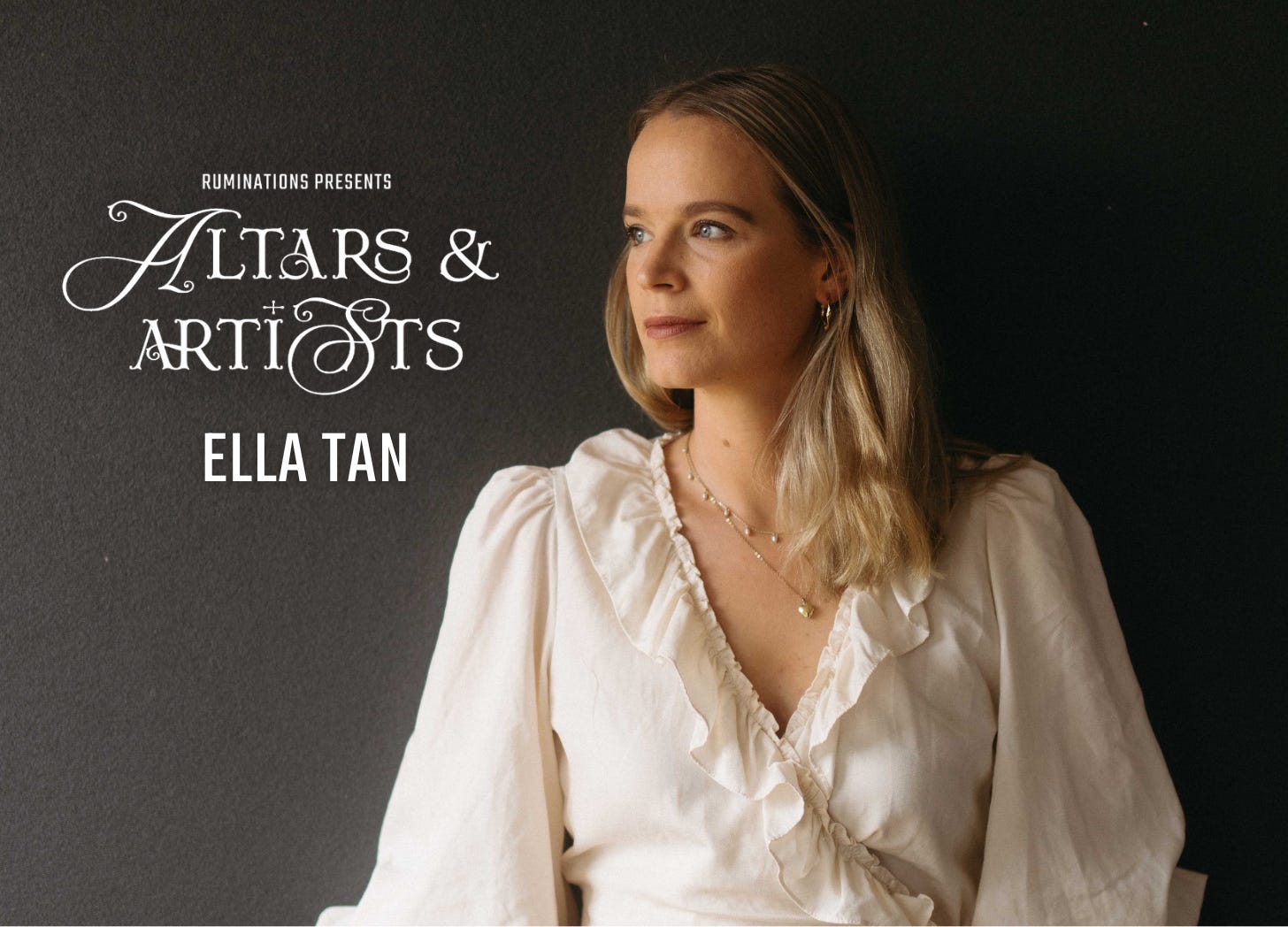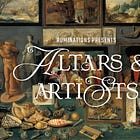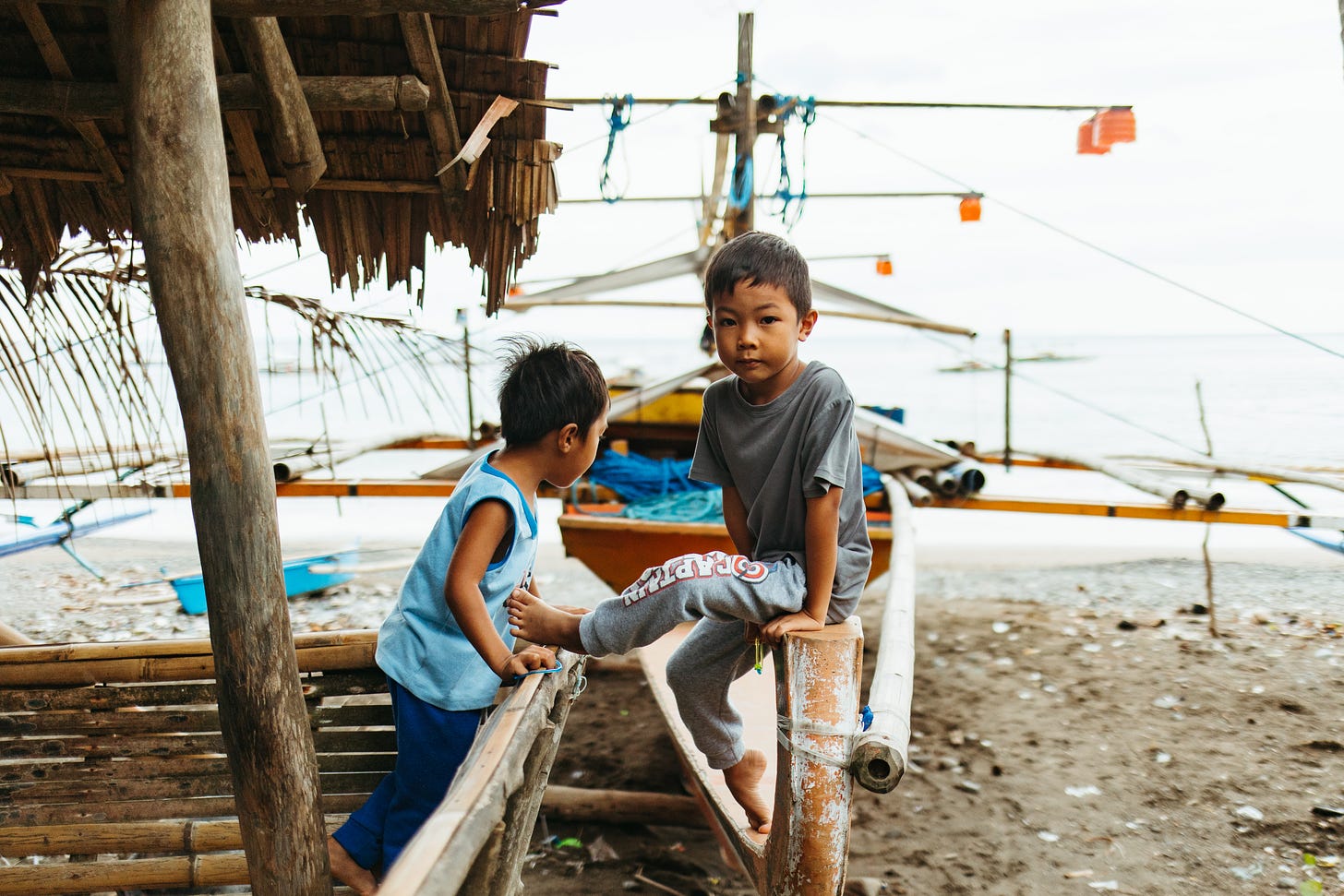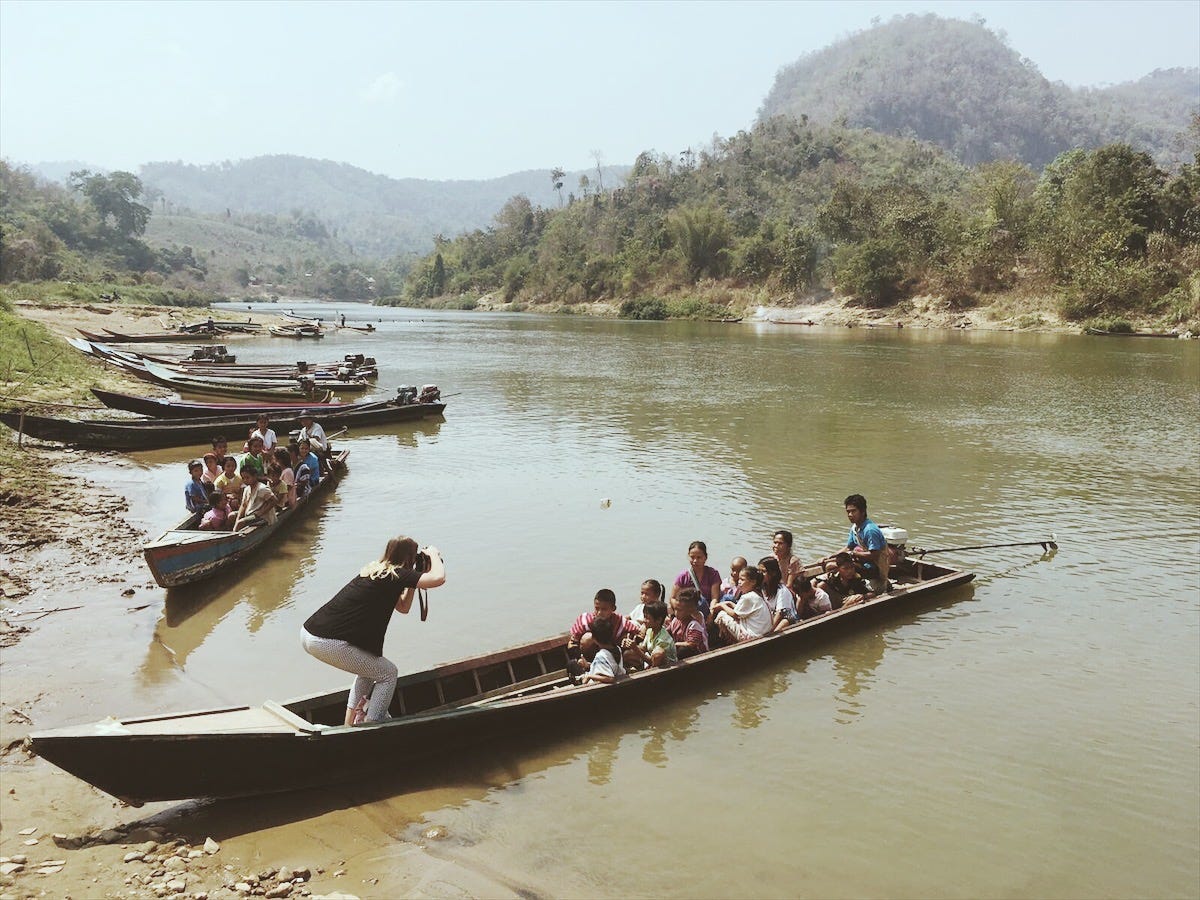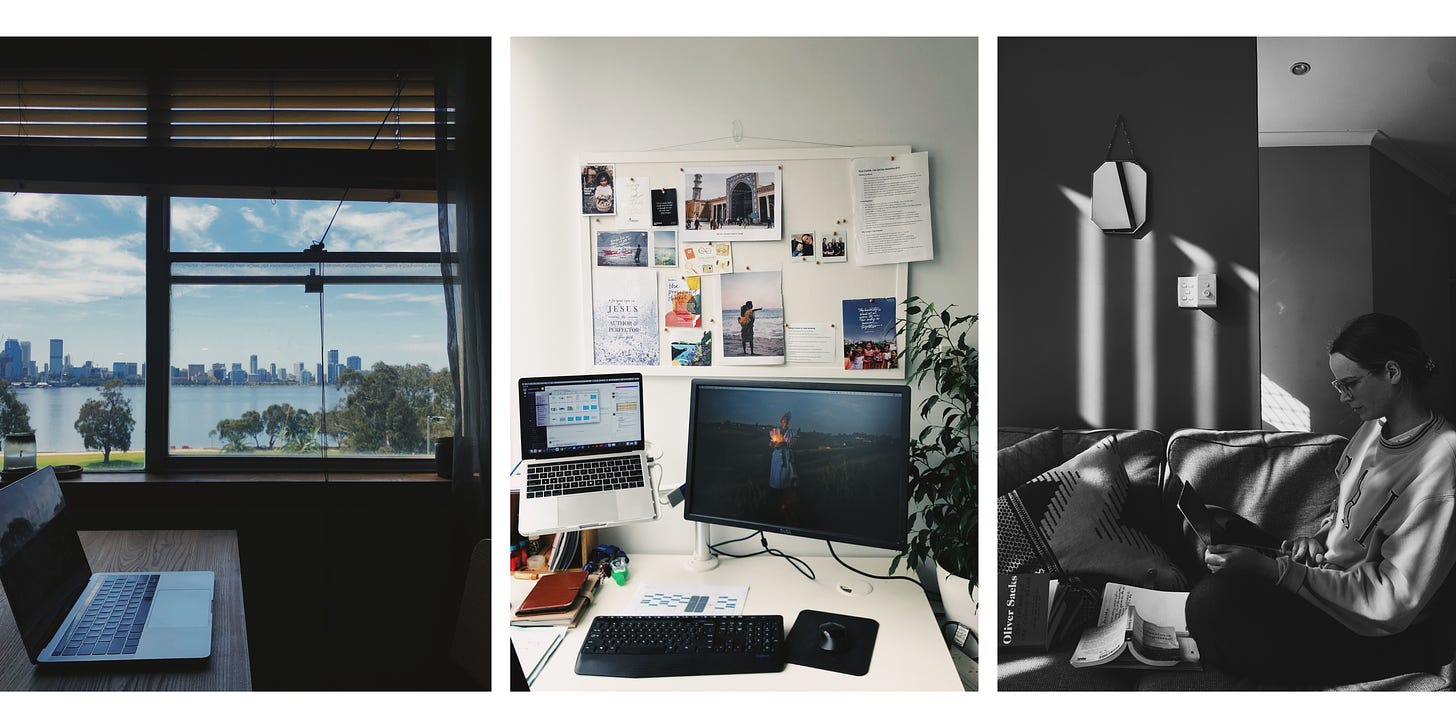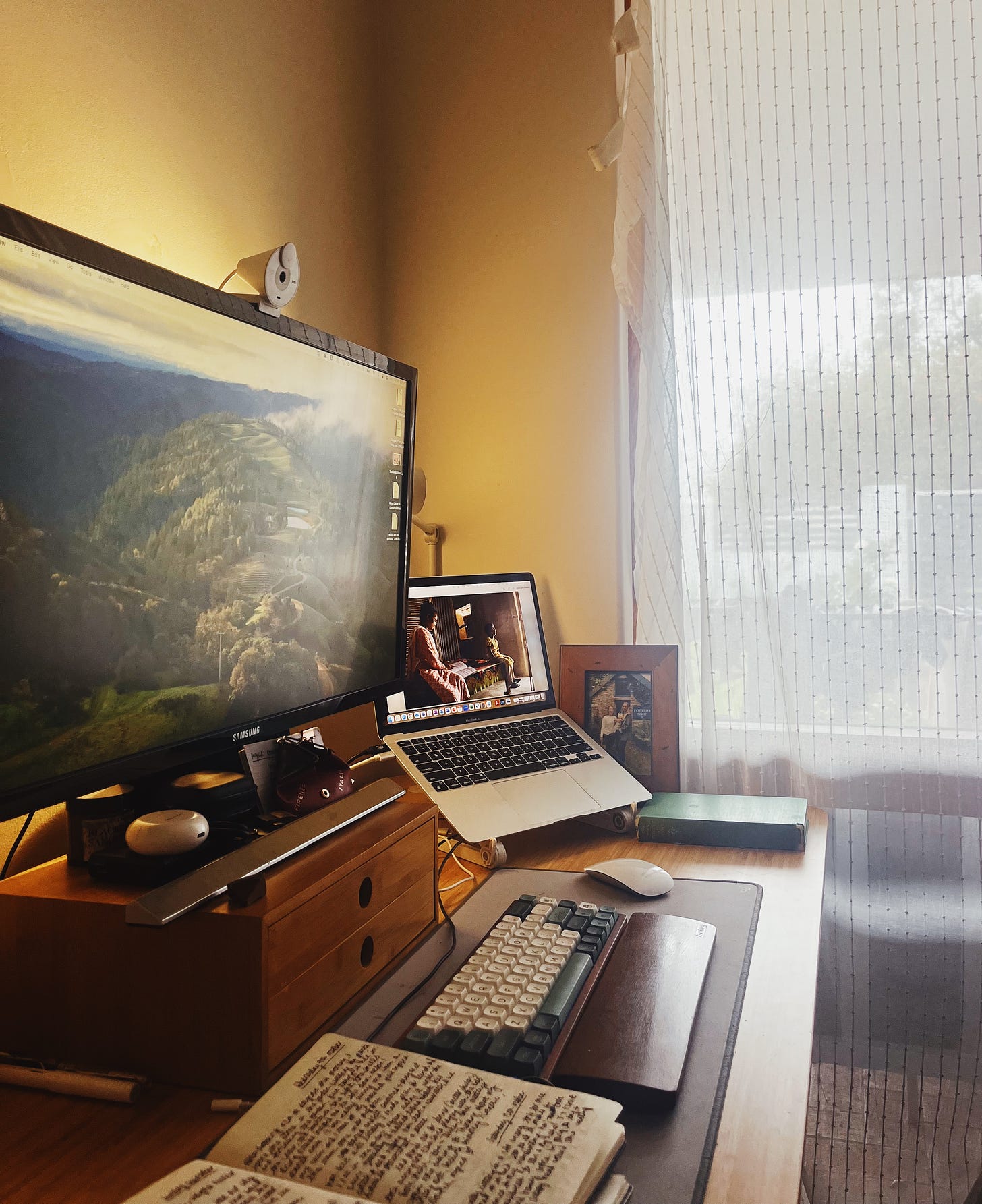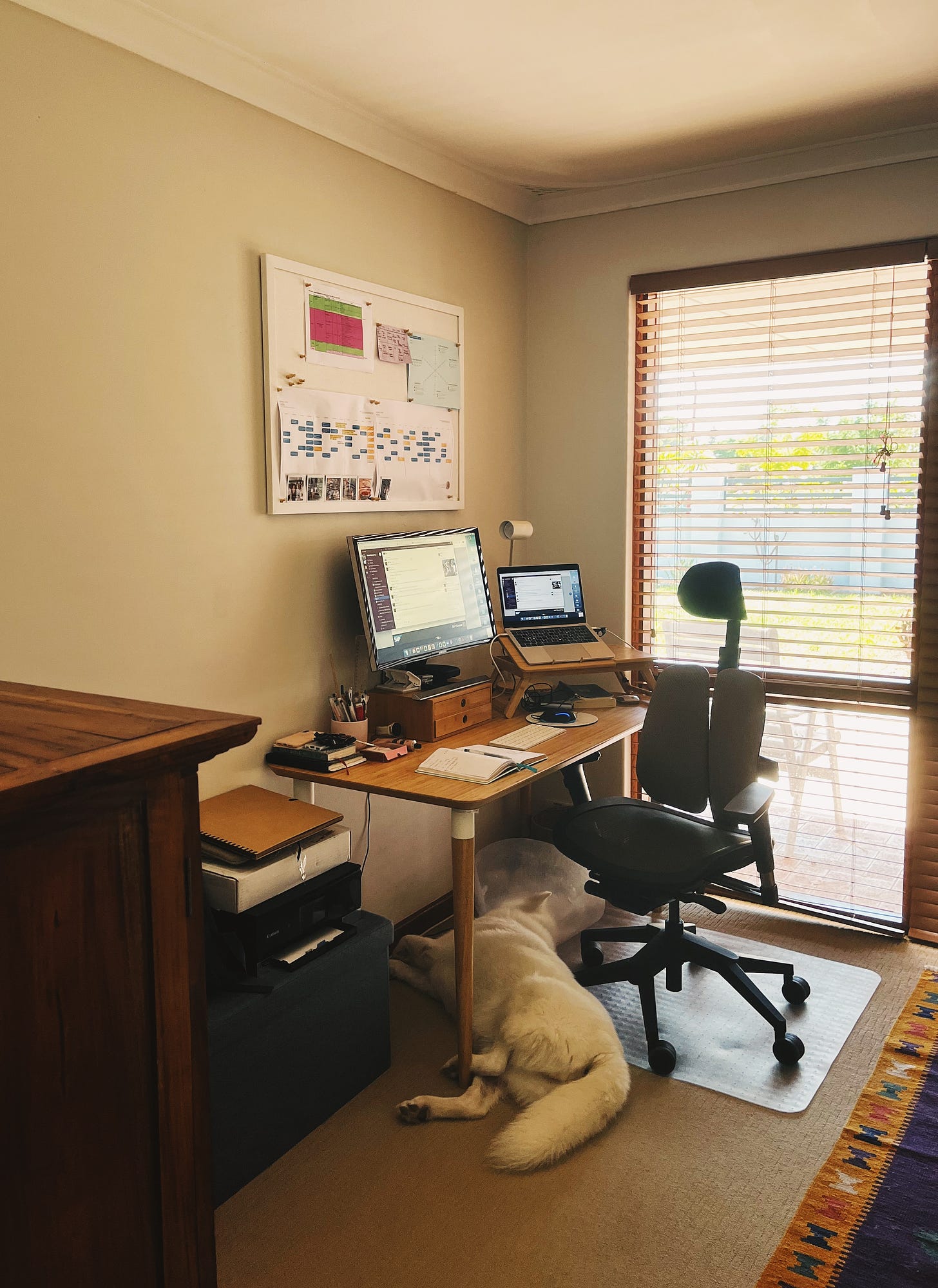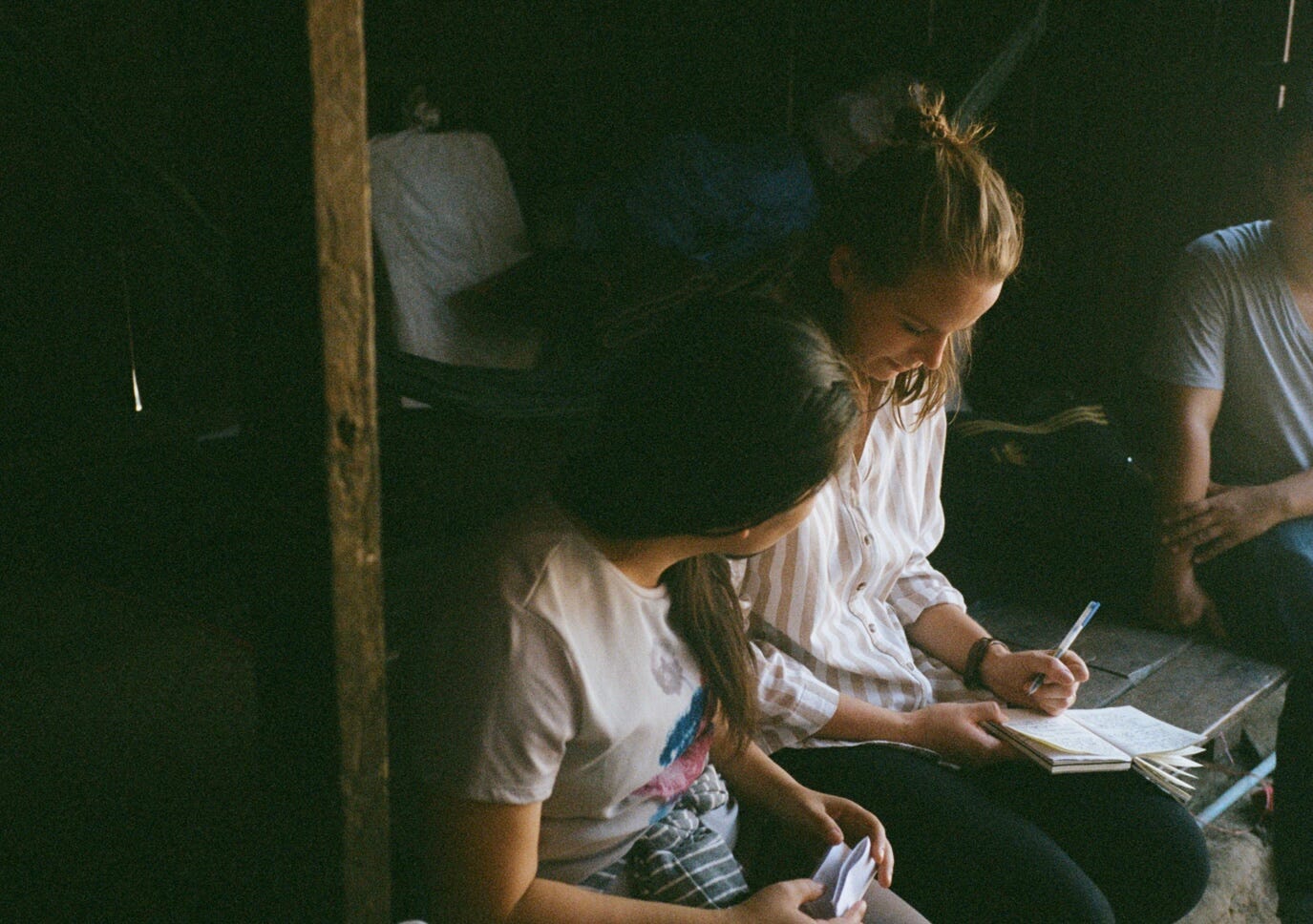Altars & Artists: Ella Tan
Interview 05: playing with light and colour, resisting compassion fatigue, and creating windows with words
Welcome to Altars & Artists, a monthly interview series divining the poetry of artists' spaces. Inspired by Gaston Bachelard’s book "The Poetics of Space" and Virginia Woolf’s extended essay "A Room of One’s Own", Altars & Artists delves into the creative spaces of contemporary artists to reveal the intimate worlds they operate within.
If you enjoy this series, please consider becoming a paid subscriber—doing so unlocks an extended cut of each interview, including a prompt made especially for you by the guest. Your contribution also keeps Ruminations running & this writer at her desk ❧
New to this series? Be sure to check out the intro post below:
Please welcome our November Altars & Artists guest — Ella Tan ❧
Ella Tan (she/her) is a Perth-based humanitarian storyteller, writer and photographer. Her work has been published in leading global outlets, including BBC, Marie Claire, Elle, Psychologies, Stylist and New Zealand’s Listener.
In 2020, she completed a collaborative project commissioned by the newly opened WA Museum Boola Bardip, sharing the stories of six refugees and asylum seekers in Perth, Western Australia. The exhibit was awarded the winner of the Research Category for the 2021 Australian Museums and Galleries National Awards.
Her career working in remote and vulnerable communities around the world started after winning the Oxfam Photography Prize for Women in 2013. The award provided assignment work in Chad’s Bahr-el-Gazel desert region, affected by climate change and successive droughts.
Her personal writing is represented by US-based agent, Don Pape from Pape Commons. She was awarded the KSP Poetry Prize for an Unpublished West Australia poet in 2022.
Questions & Curiosities
Welcome to Ruminations Ella! Thank you so much for joining us. Could you please begin by telling us a bit about yourself?
ET: Thank you for including me in this series—it’s humbling to be interviewed alongside so many talented artists.
I’m originally from a small town in Southwest England but have lived in Perth for almost seven years now. I moved here because I was offered a job with a global not-for-profit in the Asia Pacific Region. Although I’m a long way from ‘home’ and my family, I enjoy life in Perth with my husband (he’s from here) and our two-year-old son.
My first blog was a Google Blogspot when I was 15 years old; I just wrote for a handful of friends and family. I’ve enjoyed finding a new home for my writing on Substack all these years later!
is the newsletter you’ve curated to share “short essays and reflections on the seen, unseen and the in-between”. Your pieces never cease to move me, and I am forever inspired by the genuine care that underscores your work. How have years of tenderly observing spaces, places, and people from across the globe shaped your photographic language and your voice as a writer?ET: I used to think I needed to have all the answers or understand everything I saw around me. It’s taken me many years to realise that writing and photography have been tools for me to lean into nuance, mystery, inexplainable pain and undiscovered possibilities.
I take a photograph within a fraction of a second, but the people in the pictures and their stories can’t be told, or understood, anywhere near as fast. An image of a first-time voter doesn’t reveal the immeasurable points of influence in their final mark on the ballot paper. An image of a child climbing towers of desert sand against his classroom wall doesn’t show his people’s hunger or the shifting climate. An image of a boat full of tired children doesn’t explain what they are leaving behind.
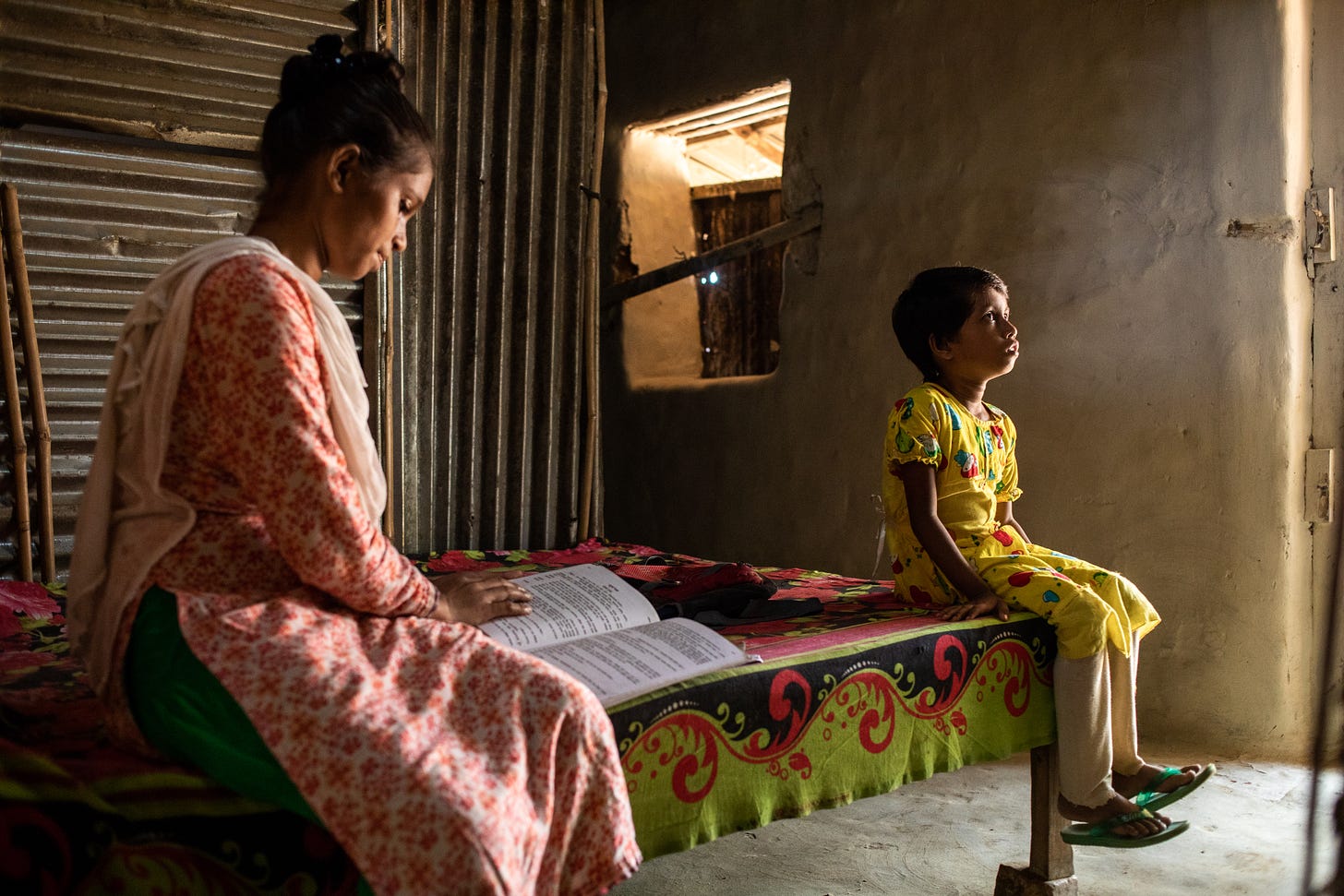
These are images I have taken in Kenya, Chad, and the Thailand-Myanmar border region. Photographs do not explain themselves. I have learned that writing is a tool for contextualising, exploring, and questioning the images I take and the images I see.
Although you’re originally from Wiltshire in the UK, you’ve set down roots in Perth/Boorloo, Australia. What is it like to be an artist living and creating in a different country to the one you grew up in?
ET: On the homesick days, of which there are many, I try to remember that my little world is stretched larger because of love. Love means my home address is written on opposite shores of the same ocean. As an artist and storyteller, the differences between these two countries—and any place I experience—inspire my work.
For a season, I sat in classes learning the local indigenous language, Noongar. As a speaker of Swahili, a language spoken in East Africa, I loved the phonetic base and how bonded the land the language is. I love the way language reveals memory and meaning.
The Walpiri people, from Australia’s Northern Territories, don’t have a term for the word “colour”. They categorise sight roughly into four groups; objects clearly visible or against a background, objects that shine, (either nearby or from a distance, like a rock pool in the desert), objects that have contrast and patterns (things that are speckled or striped), and lastly (my favourite), scenes with a familiar or attractive view, like a fire with rising smoke or vegetation after it has rained. It’s a language coloured with imagery. Half a century ago, a researcher noticed that asking the Walpiri “What colour is it?” was almost unanswerable. But asking “What is it like?” or “What is it like when people see it?” was. To the Walpiri, colour is inseparable from proximity and texture and light and familiarity. For them, seeing is inseparable from community, story, memory, perception and home. What would it be like to see without the limits of my words, defined by my culture?
Language can oppress people or help to set them free—I see this in my work with people living in extreme poverty.
Every day, my body experiences how different the climate, landscape, and seasons are here in Australia compared to where I grew up. I think this is partly why colour, texture, and light shape so much of my writing.
In one of my favourite essays of yours, In praise of a frame, you reflect on your need for containment, for “…edges to create good work; word counts, the borders of a single page, feedback, a topic, a title, a byline.” I wondered if your creative spaces, your altars, also act as frames for your creativity.
ET: Yes! As a photographer, I’m used to looking at the world through a small window. As a writer, I try to create windows with words; ways for people to be seen and to see.
As a parent who works full-time, I must make the most of the time that I have—these are also tiny windows. Those thirty minutes might be all I have that week to write.
I can only really write well near a window, or better, outside. I’ll often draft essays or ideas in my head as I’m watering the garden or taking our son to the bike park. My creative space and desk space are constantly changing, on-the-go, or temporary.
Each time I sit down to write, it sometimes feels as if I’m laying an altar wherever I am, placing a pebble down in the chaos. People in ancient scriptures did the same, whispering, “I won’t forget this. God has been here.”
Let’s have a closer look at your current space:
ET: Currently my desk looks out onto our little garden here in Perth. I can see the Wagtail birds dive over the lawn, and the postman come and go. My view isn’t static and is constantly changing from dawn to dusk.
One of my favourite places to write is along the Wild Atlantic Way in Ireland. My grandmother was born in a small village on the coast, and whenever I return, I’m inspired in my writing and visual art.
“Each time I sit down to write, it sometimes feels as if I’m laying an altar wherever I am, placing a pebble down in the chaos.”
Are there any artists who have inspired or framed your creative spaces?
ET: The photography of Alex Webb, especially his book The Suffering of Light, and how he shoots colour, layers and gestures into his images. His frames are evocative, relatable and layered. I want my writing to be this too.
I try to remember that what I do matters more to me where I do it—more than the space itself. When I sit down to write, I remember the words of Anne Lamott in Bird By Bird,
“If something inside of you is real, we will probably find it interesting, and it will probably be universal. So you must risk placing real emotion at the center of your work. Write straight into the emotional center of things. Write toward vulnerability. Risk being unliked. Tell the truth as you understand it. If you’re a writer, you have a moral obligation to do this. And it is a revolutionary act—truth is always subversive.”
If there is a constant ideal in my writing space, this is it!
In October & November: Polaroids | Resisting Compassion Fatigue, you gently remind your readers that their “minutes are punctuated by limited heartbeats”. How do you turn that gentleness inwards and make space for yourself when the world feels too big and your time within it too little?
ET: A few years ago, I realised that the kind of humanitarian work I wanted to do wasn’t sustainable if I didn’t learn to accept my limitations. I had to accept I couldn’t be everywhere and care about everything. I had to accept that if I was to care about the world in need, I had to make sure my own needs were being met first—spiritually, emotionally, physically.
I’ve had to learn to travel less, journal more, spend more time outdoors just walking, and also monitor my exposure to world news. There is a wisdom and ‘effortless delight’ (Wayne Muller) that comes with resting in stillness.
Playing, making, and creating have been crucial antidotes to the helplessness I’ve experienced from vicarious trauma and compassion fatigue.
Thank you for sharing your altars with us today, Ella. Before we move on to the next segment for our paid subscribers, can you give us a glimpse into any of the projects you’re working on?
ET: This month, I’m wrapping up a family memoir project I’ve worked on with my parents for four years. It’s called ‘Shoebox Stories’ and will result in a small run of published copies for my family.
I’m editing a manuscript for a long-term book project ready for pitching to publishers again in November.
I also enjoy painting and drawing, and I’m figuring out how to weave this into my writing and photography. The closest I’ve got so far is this project: The sisterhood of the travelling sketchbook, and I recently bought a new travel set of paint.
Keep up to date with Ella and her latest work:
Substack:
Instagram: @ellagrace_tan
Before you leave us with your creative prompt, we have some rapid-fire questions for you. So! Without further ado…
Keep reading with a 7-day free trial
Subscribe to Ruminations to keep reading this post and get 7 days of free access to the full post archives.






